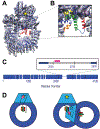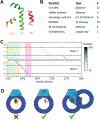SSEThread: Integrative threading of the DNA-PKcs sequence based on data from chemical cross-linking and hydrogen deuterium exchange
- PMID: 31570166
- PMCID: PMC6903780
- DOI: 10.1016/j.pbiomolbio.2019.09.003
SSEThread: Integrative threading of the DNA-PKcs sequence based on data from chemical cross-linking and hydrogen deuterium exchange
Abstract
X-ray crystallography and electron microscopy maps resolved to 3-8 Å are generally sufficient for tracing the path of the polypeptide chain in space, while often insufficient for unambiguously registering the sequence on the path (i.e., threading). Frequently, however, additional information is available from other biophysical experiments, physical principles, statistical analyses, and other prior models. Here, we formulate an integrative approach for sequence assignment to a partial backbone model as an optimization problem, which requires three main components: the representation of the system, the scoring function, and the optimization method. The method is implemented in the open source Integrative Modeling Platform (IMP) (https://integrativemodeling.org), allowing a number of different terms in the scoring function. We apply this method to localizing the sequence assignment within a 199-residue disordered region of three structured and sequence unassigned helices in the DNA-PKcs crystallographic structure, using chemical crosslinks, hydrogen deuterium exchange, and sequence connectivity. The resulting ensemble of threading models provides two major solutions, one of which suggests that the crucial ABCDE cluster of phosphorylation sites cannot undergo intra-molecular autophosphorylation without a conformational rearrangement. The ensemble of solutions embodies the most accurate and precise sequence threading given the available information.
Keywords: DNA-PKcs; Electron microscopy; Integrative modeling; Threading; X-ray crystallography.
Copyright © 2019 Elsevier Ltd. All rights reserved.
Figures






Similar articles
-
Unraveling the complexities of DNA-dependent protein kinase autophosphorylation.Mol Cell Biol. 2014 Jun;34(12):2162-75. doi: 10.1128/MCB.01554-13. Epub 2014 Mar 31. Mol Cell Biol. 2014. PMID: 24687855 Free PMC article.
-
Modeling Biological Complexes Using Integrative Modeling Platform.Methods Mol Biol. 2019;2022:353-377. doi: 10.1007/978-1-4939-9608-7_15. Methods Mol Biol. 2019. PMID: 31396911
-
Measuring the hydrogen/deuterium exchange of proteins at high spatial resolution by mass spectrometry: overcoming gas-phase hydrogen/deuterium scrambling.Acc Chem Res. 2014 Oct 21;47(10):3018-27. doi: 10.1021/ar500194w. Epub 2014 Aug 29. Acc Chem Res. 2014. PMID: 25171396 Review.
-
The DNA-dependent protein kinase catalytic subunit is phosphorylated in vivo on threonine 3950, a highly conserved amino acid in the protein kinase domain.Mol Cell Biol. 2007 Mar;27(5):1581-91. doi: 10.1128/MCB.01962-06. Epub 2006 Dec 11. Mol Cell Biol. 2007. PMID: 17158925 Free PMC article.
-
Understanding the structure and role of DNA-PK in NHEJ: How X-ray diffraction and cryo-EM contribute in complementary ways.Prog Biophys Mol Biol. 2019 Oct;147:26-32. doi: 10.1016/j.pbiomolbio.2019.03.007. Epub 2019 Apr 20. Prog Biophys Mol Biol. 2019. PMID: 31014919 Review.
Cited by
-
Comprehensive structure and functional adaptations of the yeast nuclear pore complex.Cell. 2022 Jan 20;185(2):361-378.e25. doi: 10.1016/j.cell.2021.12.015. Epub 2022 Jan 3. Cell. 2022. PMID: 34982960 Free PMC article.
-
Structural basis of long-range to short-range synaptic transition in NHEJ.Nature. 2021 May;593(7858):294-298. doi: 10.1038/s41586-021-03458-7. Epub 2021 Apr 14. Nature. 2021. PMID: 33854234 Free PMC article.
-
From integrative structural biology to cell biology.J Biol Chem. 2021 Jan-Jun;296:100743. doi: 10.1016/j.jbc.2021.100743. Epub 2021 May 4. J Biol Chem. 2021. PMID: 33957123 Free PMC article. Review.
-
Uncovering DNA-PKcs ancient phylogeny, unique sequence motifs and insights for human disease.Prog Biophys Mol Biol. 2021 Aug;163:87-108. doi: 10.1016/j.pbiomolbio.2020.09.010. Epub 2020 Oct 6. Prog Biophys Mol Biol. 2021. PMID: 33035590 Free PMC article.
-
The active DNA-PK holoenzyme occupies a tensed state in a staggered synaptic complex.Structure. 2021 May 6;29(5):467-478.e6. doi: 10.1016/j.str.2020.12.006. Epub 2021 Jan 6. Structure. 2021. PMID: 33412091 Free PMC article.
References
-
- Alber F, Dokudovskaya S, Veenhoff LM, Zhang W, Kipper J, Devos D, Suprapto A, Karni-Schmidt O, Williams R, Chait BT, Rout MP, Sali A, 2007. Determining the architectures of macromolecular assemblies. Nature 450, 683–694. - PubMed
-
- Alber F, Förster F, Korkin D, Topf M, Sali A, 2008. Integrating diverse data for structure determination of macromolecular assemblies. Annu Rev Biochem 77, 443–477. - PubMed
Publication types
MeSH terms
Substances
Grants and funding
LinkOut - more resources
Full Text Sources
Molecular Biology Databases

